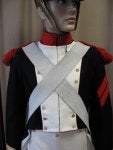So the button hole on your left lapel is a vestige of times when the jacket could be fully closed viâ a corresponding button under the right lapel. From what I understand this feature still exits on sports jackets; they feature a tab above the lapel and attach to a 'storm button' but any button hole on the lapel itself will never have a corresponding button.
I'm solely curious as to when jackets stopped being made so that they were able to close up. Could jackets themselves ever close up? Or are button holes a leftover from morning coats and their equestrian origins? Did formal dress of any kind ever accommodate a functional pair of lapels or was this solely a sporting feature? I doubt the feature is actually too useful, at least nothing a scarf, overcoat and umbrella couldn't handle but my curious is peaked none hit less by this supposèd history.
I'm solely curious as to when jackets stopped being made so that they were able to close up. Could jackets themselves ever close up? Or are button holes a leftover from morning coats and their equestrian origins? Did formal dress of any kind ever accommodate a functional pair of lapels or was this solely a sporting feature? I doubt the feature is actually too useful, at least nothing a scarf, overcoat and umbrella couldn't handle but my curious is peaked none hit less by this supposèd history.












